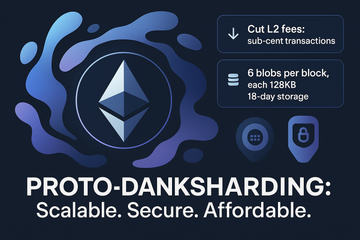If you spend any time in crypto circles, sooner or later some excited nerd (lovingly said!) will bring up EIP-4844. It rolls off the tongue, doesn’t it? Sounds cryptic, but honestly, at the core, this Ethereum upgrade is shaping up as a big deal. But why? What’s all the fuss about blobs, lower fees, and something called Proto-Danksharding? Pull up a chair—let’s make sense of EIP-4844, and why hardware wallet fans (yes, you Ledger and Trezor folks) should care.
Why Ethereum Needed a Pick-Me-Up
Let’s not kid ourselves: Ethereum’s been caught in a classic ‘can’t scale, too expensive’ tango for years. High fees? Congestion? It’s been a headache for everyone from gamers flipping NFTs to big DeFi whales moving millions. The folks behind Ethereum aren’t just sitting around—EIP-4844 is their latest answer. But before we break it down, have you ever wondered how Ethereum can promise “decentralized everything” when sometimes just sending a token feels like jamming yourself onto a crowded subway?
The Blob Era: What’s Up With EIP-4844?
EIP-4844 goes by another name—Proto-Danksharding. Catchy, isn’t it? Here’s the simple version: it lets Ethereum blocks hold something new called blobs. Think of blobs as digital cargo containers that store chunks of transaction data off to the side, for a short time. Layer 2 rollups—Optimism, Arbitrum, zkSync, you name it—can cram their receipts and proofs into these blobs rather than clogging up Ethereum’s core memory every single moment (QuickNode).
If you’re into specifics, here’s a bite: each Ethereum block can now carry up to six blobs, and each one of those blobs is 128KB in size (Consensys). That’s over three-quarters of a megabyte per block dedicated to blob data. Not too shabby, especially considering that, historically, Ethereum has kept storage needs tight to discourage unnecessary bloat.
New Data, New Rules: Blob Fees and Short-Term Storage
The clever part? Blobs are temporarily stored. Picture them like sticky notes: super useful for a spell, but the protocol tidies them away after roughly 18 days (Datawallet). You might think, doesn’t tossing data so fast risk losing something critical? Fortunately, Layer 2s only need those proofs short-term, so this strategy fits like a glove.
Blob data also has its own brand-new fee market. That means the cost of including blobs isn’t tangled up with regular transaction fees (gas). On busy days, you don’t need to panic that DeFi apes pumping up gas for a meme token trade will nudge up the cost of rollup proofs. Kinda neat, right?
Technical Bits With a Dash of Jargon (But Nothing Too Painful)
Let’s get a bit nerdy, just for a moment. The magic behind old-fashioned, reliable cryptographic verification here is called KZG commitments. If you’re not up for math, think of this as a super-compact way to prove a giant blob really did say (or not say) what’s claimed—without ever looking at the whole thing. It’s efficient, secure, and, crucially, sets the stage for even wilder scaling in the future (hello, full Danksharding!) (EIP-4844.com).
Rollups Take the Wheel – And Drive Down Fees
Rollup chains (those L2s we keep mentioning) have already adopted blobs to seriously cut their operating costs. The impact? We’re seeing L2 transaction fees easily drop into the sub-cent range, at least sometimes. Suddenly, rolling your sleeve up and moving assets around isn’t a luxury—it’s almost as cheap as sending a text. Arbitrum and Optimism, for instance, have publicly declared that blobs are letting them pass those savings on to users. Who doesn’t love that?
For hardware wallet lovers (you know who you are):
- Lower L2 fees mean more microtransactions make sense—and you can keep everything secure on your Ledger or Trezor, no compromise.
- Better security for batch settlements means you don’t have to worry that your proofs will be stuck if you wait a day or two to update your balances.
Is This the Finish Line?
No way, and that’s being honest. EIP-4844 isn’t the endgame—think of it as a dress rehearsal for ‘Danksharding’, which, if it fully launches, will upend data handling in a much bigger way. For now, blobs are training wheels for Ethereum, letting it get the hang of high-throughput, low-latency settling before the next evolution (Blocknative). It’s still pretty exciting to watch the groundwork get laid piece by piece.
Heads Up: A Few Downsides
Fair is fair—there are a couple of drawbacks. Because blobs vanish after a certain window, super-long audits or retroactive proofs might get tricky. And, as always, creative attackers are watching for loopholes. The Ethereum dev community is keeping a close eye, rolling out upgrades and patches when needed. But if you’re used to storing Bitcoin keys for decades, you’re probably already on top of regular backup routines, so this shouldn’t freak you out.
The Human Side of Scalability
Sometimes, crypto upgrades can feel sterile—lots of charts, zero personality. But EIP-4844, funny enough, is about people as much as code. Lower fees and better throughput open doors for users on every continent. NFTs start to feel less like playthings for whales and more like tools for artists in Lagos or Jakarta. Remittances get a fresh, affordable twist. And, for hardware wallet diehards, you just gained another level of flexibility. That’s not just a technical win—it’s a cultural shift.
The Takeaway
Will EIP-4844 make Ethereum perfect? No—but it’s a savvy move, shifting bottlenecks off the main rails and into scalable side lanes. Fees are tumbling. Privacy and security, already the DNA of hardware wallets, mesh perfectly with this new expansion. If you have a Trezor or Ledger, you might barely notice anything day to day—except things just work faster and cheaper.
Honestly, it’s crypto’s version of cleaning the garage—tossing out old junk, organizing tools, and getting ready for whatever big project comes next. So next time someone mentions blobs or Danksharding, just smile and think—Ethereum’s finally getting out of its own way. And in crypto, that’s half the battle won.











